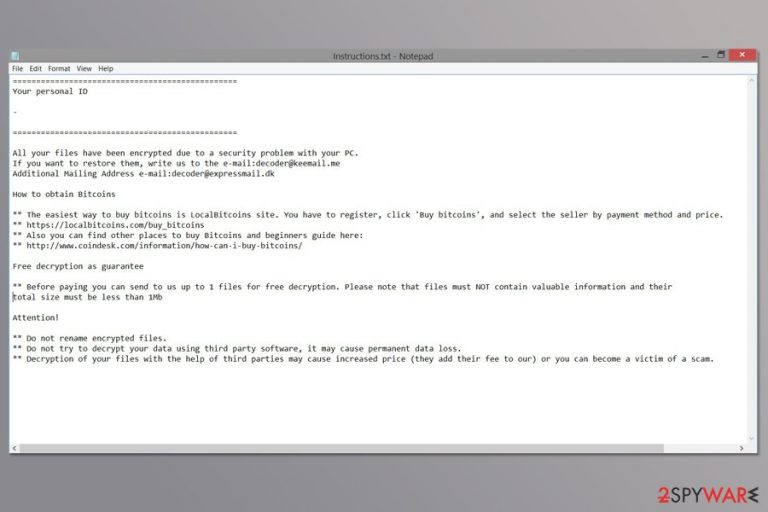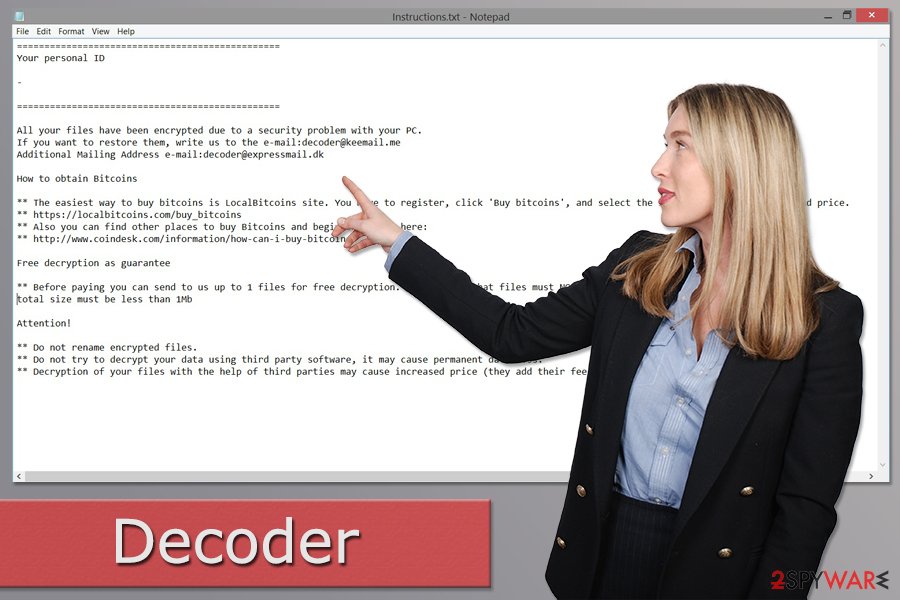Decoder ransomware / virus (Removal Guide) - Decryption Methods Included
Decoder virus Removal Guide
What is Decoder ransomware virus?
Decoder continues nasty job of the GlobeImposter ransomware virus

Decoder ransomware is a file encrypting virus that belongs to Globe Imposter ransomware family. Malware uses a strong encryption algorithm and appends the .decoder file extension to a bunch of different files. Following the encryption, it delivers a ransom demanding message in the Instructions.txt file.
The ransom note delivered by the Decoder virus starts with victim’s personal ID number and informs that files on the computer were encrypted due to “security problems” with the computer. In order to solve the issue and get back access to their records, victims are asked to send an email to decoder@keemail.me or decoder@expressmail.dk.
However, from the ransom note is clear that victims will need to pay some Bitcoins in order to get the decryption key. Though, authors of the Decoder do not reveal the size of the ransom. Thus, the payment might be set based on the number of encrypted files.
Crooks want to give guarantees that they can actually decrypt files and let people send one file for the decryption. However, the test file cannot include important information. We want to warn that this might be the only file that you recover with the help of criminals after the Decoder malware attack.
Security experts warn that this malicious program has been created for swindling the money from computer users illegally. Therefore, authors of the malware are only interested in getting your money, and data recovery is the matter of their conscience. For this reason, you should focus on Decoder removal.
It’s important to get rid of the virus because its appearance not only damages your files but makes the system vulnerable. The virus can inject malicious code into legit system processes, create or modify new Windows registry keys or install other dangerous programs. Thus, after the ransomware attack is impossible to use the affected PC safely and normally.
Crypto-virus is a dangerous and complicated cyber threat. Thus, it’s recommended to remove Decoder using reputable anti-virus or anti-malware program, such as FortectIntego.

Malware is most likely to sneak into the system via malicious spam emails
Even though there are numerous ways how ransomware might end up on your computer, the biggest chances are that malicious payload is dropped on the system when you open an infected email attachment. It might be safe looking PDF or Word file that pretends to be an invoice, statement or another important document. Thus, you have always to double-check the information about the sender, look up for grammar mistakes or other suspicious signs[1] to check if hackers did not send this email.
Additionally, the ransomware-type virus might spread via:
- malicious ads;[2]
- exploit kits;
- fake software updates;
- bogus software downloads;
- illegal content.
Security experts from the Germany[3] remind to be careful when browsing the web and opening spam emails. Users are also advised to create and update backups and install security software to minimize the risk of the attack.
Removal of the Decoder ransomware virus
First of all, we want to discourage you from manual Decoder removal. It’s a complex program that might be hard or nearly impossible to remove safely. If you try to locate and delete malicious files, you might accidentally terminate legit entries because ransomware often hides under system file names.
Therefore, you should avoid causing more damage to your computer by choosing reputable security software to remove Decoder ransomware from the computer. We recommend using FortectIntego or Malwarebytes, but you can choose your preferred tool as well. If you cannot run security software, follow the steps below.
Getting rid of Decoder virus. Follow these steps
Manual removal using Safe Mode
Folow these steps to run automatic Decoder ransomware removal:
Important! →
Manual removal guide might be too complicated for regular computer users. It requires advanced IT knowledge to be performed correctly (if vital system files are removed or damaged, it might result in full Windows compromise), and it also might take hours to complete. Therefore, we highly advise using the automatic method provided above instead.
Step 1. Access Safe Mode with Networking
Manual malware removal should be best performed in the Safe Mode environment.
Windows 7 / Vista / XP
- Click Start > Shutdown > Restart > OK.
- When your computer becomes active, start pressing F8 button (if that does not work, try F2, F12, Del, etc. – it all depends on your motherboard model) multiple times until you see the Advanced Boot Options window.
- Select Safe Mode with Networking from the list.

Windows 10 / Windows 8
- Right-click on Start button and select Settings.

- Scroll down to pick Update & Security.

- On the left side of the window, pick Recovery.
- Now scroll down to find Advanced Startup section.
- Click Restart now.

- Select Troubleshoot.

- Go to Advanced options.

- Select Startup Settings.

- Press Restart.
- Now press 5 or click 5) Enable Safe Mode with Networking.

Step 2. Shut down suspicious processes
Windows Task Manager is a useful tool that shows all the processes running in the background. If malware is running a process, you need to shut it down:
- Press Ctrl + Shift + Esc on your keyboard to open Windows Task Manager.
- Click on More details.

- Scroll down to Background processes section, and look for anything suspicious.
- Right-click and select Open file location.

- Go back to the process, right-click and pick End Task.

- Delete the contents of the malicious folder.
Step 3. Check program Startup
- Press Ctrl + Shift + Esc on your keyboard to open Windows Task Manager.
- Go to Startup tab.
- Right-click on the suspicious program and pick Disable.

Step 4. Delete virus files
Malware-related files can be found in various places within your computer. Here are instructions that could help you find them:
- Type in Disk Cleanup in Windows search and press Enter.

- Select the drive you want to clean (C: is your main drive by default and is likely to be the one that has malicious files in).
- Scroll through the Files to delete list and select the following:
Temporary Internet Files
Downloads
Recycle Bin
Temporary files - Pick Clean up system files.

- You can also look for other malicious files hidden in the following folders (type these entries in Windows Search and press Enter):
%AppData%
%LocalAppData%
%ProgramData%
%WinDir%
After you are finished, reboot the PC in normal mode.
Remove Decoder using System Restore
-
Step 1: Reboot your computer to Safe Mode with Command Prompt
Windows 7 / Vista / XP- Click Start → Shutdown → Restart → OK.
- When your computer becomes active, start pressing F8 multiple times until you see the Advanced Boot Options window.
-
Select Command Prompt from the list

Windows 10 / Windows 8- Press the Power button at the Windows login screen. Now press and hold Shift, which is on your keyboard, and click Restart..
- Now select Troubleshoot → Advanced options → Startup Settings and finally press Restart.
-
Once your computer becomes active, select Enable Safe Mode with Command Prompt in Startup Settings window.

-
Step 2: Restore your system files and settings
-
Once the Command Prompt window shows up, enter cd restore and click Enter.

-
Now type rstrui.exe and press Enter again..

-
When a new window shows up, click Next and select your restore point that is prior the infiltration of Decoder. After doing that, click Next.


-
Now click Yes to start system restore.

-
Once the Command Prompt window shows up, enter cd restore and click Enter.
Bonus: Recover your data
Guide which is presented above is supposed to help you remove Decoder from your computer. To recover your encrypted files, we recommend using a detailed guide prepared by 2-spyware.com security experts.If your files are encrypted by Decoder, you can use several methods to restore them:
Data Recovery Pro might help after the ransomware attack
This tool might help to restore files after system wreckage or corrupted data. However, it might also help after the ransomware attack.
- Download Data Recovery Pro;
- Follow the steps of Data Recovery Setup and install the program on your computer;
- Launch it and scan your computer for files encrypted by Decoder ransomware;
- Restore them.
Try Windows Previous versions feature
If System Restore has been enabled before ransomware attack, you can follow these steps and recover individual versions of important data:
- Find an encrypted file you need to restore and right-click on it;
- Select “Properties” and go to “Previous versions” tab;
- Here, check each of available copies of the file in “Folder versions”. You should select the version you want to recover and click “Restore”.
Take advantage of the ShadowExplorer
ShadowExplorer can restore files from Shadow Volume Copies. Hence, if Decoder did not delete them, follow these steps:
- Download Shadow Explorer (http://shadowexplorer.com/);
- Follow a Shadow Explorer Setup Wizard and install this application on your computer;
- Launch the program and go through the drop down menu on the top left corner to select the disk of your encrypted data. Check what folders are there;
- Right-click on the folder you want to restore and select “Export”. You can also select where you want it to be stored.
Try Globe Imposter decryptor
Decoder ransomware virus is a variant of GlobeImposter which is decryptable. Thus, you can try to use its decryptor too.
Finally, you should always think about the protection of crypto-ransomwares. In order to protect your computer from Decoder and other ransomwares, use a reputable anti-spyware, such as FortectIntego, SpyHunter 5Combo Cleaner or Malwarebytes
How to prevent from getting ransomware
Protect your privacy – employ a VPN
There are several ways how to make your online time more private – you can access an incognito tab. However, there is no secret that even in this mode, you are tracked for advertising purposes. There is a way to add an extra layer of protection and create a completely anonymous web browsing practice with the help of Private Internet Access VPN. This software reroutes traffic through different servers, thus leaving your IP address and geolocation in disguise. Besides, it is based on a strict no-log policy, meaning that no data will be recorded, leaked, and available for both first and third parties. The combination of a secure web browser and Private Internet Access VPN will let you browse the Internet without a feeling of being spied or targeted by criminals.
No backups? No problem. Use a data recovery tool
If you wonder how data loss can occur, you should not look any further for answers – human errors, malware attacks, hardware failures, power cuts, natural disasters, or even simple negligence. In some cases, lost files are extremely important, and many straight out panic when such an unfortunate course of events happen. Due to this, you should always ensure that you prepare proper data backups on a regular basis.
If you were caught by surprise and did not have any backups to restore your files from, not everything is lost. Data Recovery Pro is one of the leading file recovery solutions you can find on the market – it is likely to restore even lost emails or data located on an external device.
- ^ Ian Paul. Three warning signs that email is malicious. PCWorld. News, tips and reviews on PCs, Windows and more.
- ^ Simon Batt. What “Malvertising” Is, How It Affects You and How to Stop It. Make Tech Easier. Computer tutorials, tips and tricks.
- ^ DieViren. DieViren. German cyber security news.







